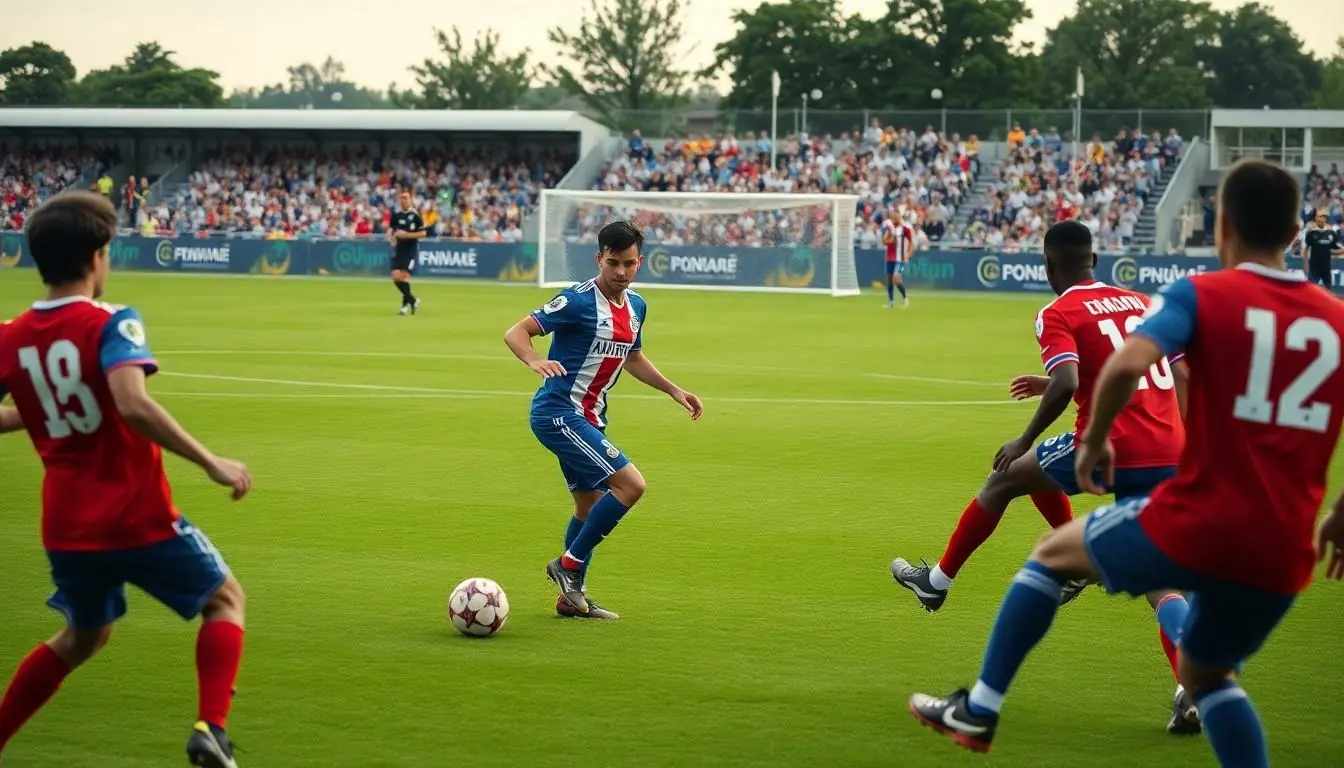Football manager tactics can feel like the secret sauce that turns a mediocre team into a league champion. Whether you’re a seasoned tactician or just starting your journey in the world of virtual football, mastering these strategies can elevate your game from “meh” to “magnificent.” Imagine orchestrating a symphony of passes that leaves your opponents scratching their heads and your fans on their feet.
Table of Contents
ToggleOverview of Football Manager Tactics
Football manager tactics encompass strategies that shape how a team performs on the field. Techniques such as formations, player roles, and tactical instructions significantly influence the game’s outcome. Managers can utilize formations like 4-4-2 or 3-5-2 to create balance between defense and attack.
Each player has specific roles within these formations, such as forward, midfielder or defender, requiring distinct skills and responsibilities. For instance, wing-backs play crucial roles in both defense and initiating attacks, while a target man in the forward position helps in holding up play.
Set-pieces often play a pivotal role in success. Well-rehearsed corner and free-kick strategies can convert opportunities into goals, giving teams an edge. Anticipating opponents’ tactics furthers a manager’s ability to adjust strategies during matches.
In-game adjustments remain vital. Digital tools allow managers to tweak formations based on the opponent’s performance, player fatigue or match conditions. For example, switching to a more defensive formation in the final minutes can secure a lead.
Ultimately, mastering football manager tactics enhances gameplay, enables better decisions and increases the potential for victories. Understanding how to adjust these tactics boosts a team’s chances of outsmarting opponents and achieving success in competitive environments.
Key Tactical Concepts
Football manager tactics revolve around strategic elements crucial for performance. Understanding these concepts enhances gameplay and can lead to greater success on the field.
Formation and Shape
Formation defines the team’s structure during a match. Common formations such as 4-4-2 and 3-5-2 provide different defensive and offensive strengths. A 4-4-2 formation emphasizes balanced play, with four defenders and four midfielders creating a strong core. Meanwhile, the 3-5-2 formation focuses on midfield supremacy, allowing for greater ball control. Shape influences space utilization, making it essential for players to maintain their positions. Adjusting formation based on the opponent’s strategy maximizes effectiveness and increases scoring opportunities. Key formations must match the team’s strengths while exploiting the opponent’s weaknesses.
Player Roles and Responsibilities
Player roles dictate specific duties within the team structure. Each position requires distinct skill sets and responsibilities. For instance, strikers focus on scoring goals, while defenders prioritize preventing them. Midfielders often serve as playmakers, linking defense and attack by distributing the ball effectively. Wingers complement the attacking options by utilizing width and speed. Additionally, understanding individual strengths allows managers to allocate roles that enhance team coherence. Clear communication of responsibilities ensures players act decisively during gameplay. Managers benefit from analyzing player performances to adjust roles when needed, optimizing team dynamics for success.
Developing Your Tactical Approach
Effective tactical approaches transform gameplay and boost overall performance. Managers must analyze various facets of tactics to craft their strategies.
Analyzing Opponent Strategies
Understanding the opponent’s strengths and weaknesses plays a vital role in developing an effective game plan. Managers should scout opponents regularly to gather information on play styles, formations, and key players. Observing past matches can reveal patterns in tactical approaches. Identifying weaknesses in the opponent’s defense, like vulnerability to counter-attacks, allows for targeted strategies. Noticing how teams respond to different formations aids in creating advantageous matchups. In-depth analysis provides a foundation for adapting tactics pre-match and during the game.
Adjusting Tactics During Matches
In-game adjustments are crucial for maintaining competitive advantage. Managers must assess performance and recognize when a shift in strategy becomes necessary. Evaluating player fatigue, opposition tactics, and match flow guides decisions on substitutions and tactical changes. Altering formations or player roles mid-match can exploit an opponent’s weaknesses. A proactive approach enables teams to react to unforeseen circumstances, such as injuries or an early goal scored by the rival. Utilization of available digital tools enhances real-time tactical adjustments, amplifying success potential.
Common Tactical Styles in Football Manager
Football Manager features various tactical styles that can greatly influence a team’s success on the pitch. Understanding these styles equips managers with tools to adapt gameplay to specific strategies.
Possession-Based Tactics
Possession-based tactics prioritize ball control and patient buildup play. Teams utilizing this approach often dominate possession percentages, creating opportunities through short, quick passes. Players maintain close proximity to facilitate triangles, allowing for fluid movement and ball retention. Formations such as 4-3-3 or 4-2-3-1 excel in these setups, providing ample midfield support. A manager may also emphasize player roles that promote creativity and vision, such as advanced playmakers. By drawing opponents out of position, a possession-focused strategy creates space for attacking plays, increasing the likelihood of scoring.
Counter-Attacking Tactics
Counter-attacking tactics focus on exploiting opponents’ defensive vulnerabilities after winning the ball. Teams rapidly transition from defense to attack, often capitalizing on opponents caught out of position. This style thrives with formations like 4-4-2 or 3-5-2, ensuring defensive solidity and quick outlet options. Speedy wingers and strikers are crucial, as they help in breaking down defenses swiftly. A successful counter-attacking strategy relies on precise passing and effective movement to create goal-scoring chances. Managers often analyze defensive patterns of opponents to maximize opportunities during quick breaks.
Conclusion
Mastering football manager tactics can significantly elevate a team’s performance. By understanding formations player roles and in-game adjustments managers can create a dynamic and effective game plan. The ability to analyze opponents and adapt strategies in real-time is crucial for success in competitive environments.
Utilizing different tactical styles like possession-based or counter-attacking approaches allows teams to exploit their strengths while addressing weaknesses. This adaptability not only enhances gameplay but also fosters excitement among fans and players alike. Embracing these tactics can lead to memorable victories and a more engaging football experience.





